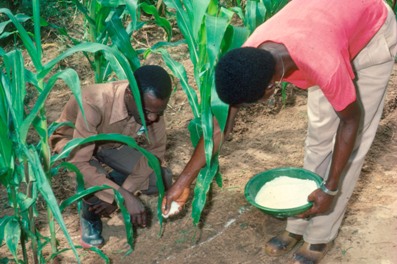
Science and technology in agriculture are once again a focus for policy attention. Many argue that a way out of the
current productivity bind – particularly in Africa – is to invest in technology development. The Green Revolution in Asia in the 1960s and 70s is often referred to as a model, with the need to invest in (re)building scientific capacity, particularly in Africa. Thus the Commission for Africa argued for up to $3 billion over a decade earmarked investment particularly in building regional ‘centres of excellence’ across the continent. Similarly, the Millennium Project’s reports both on Science and Technology and on hunger both agreed that technological advances were key to meeting MDG goals. A joint UK-Canada report on science and technology has also recommended that significant donor funds for Africa are pushed towards technology development and building capacity of African science institutions.
African organisations, such as NEPAD and the Forum for Agricultural Research in Africa also argue for a revitalisation of African R&D capacity in agriculture. Meanwhile, the UK’s Department for International Development (DFID) is busy preparing a new science and innovation strategy in parallel with new announcements for investing significant research funds in ‘ecoregional’ hubs for agricultural research, again focusing on Africa. Such policy activity is unprecedented. Not since the hey-day of the 1970s when technological change was seen to be the core driver of developmental advances has S&T policy seen such a profile. While many assessments have shown the positive returns to investment in agricultural research, the causal relationships and the contexts for positive impacts are not always clear.
An assessment of CGIAR investments and their livelihood impacts showed just how complex these relationships are. Reviews of the CGIAR system as a whole following its 30 year anniversary have equally shown some significant advances, but also some slow or limited wins. While the argument that S&T is essential to turning African agriculture around has been largely won, exactly what this should involve remains a subject of much debate. In the context of the country work of the Future Agricultures consortium, the teams will be asking what works well where and why? Should new funds be invested in regional centres of technical excellence, attracting diaspora expertise back to the continent?
Should new funds be pumped into the international research system, with the CGIAR centres expected to come up with big impact spill-over technologies? Or should money be spent on rebuilding the crumbling research and extension infrastructure and personnel base at a national level? Or are there other options, outside the conventional institutional routes, that bring in alternative expertise – and particularly farmers’ own innovation experience – into revitalised innovation systems that cut across public/state, private/corporate and community/farmer led processes? With the funds being promised – most recently at the 2nd African Ministerial Conference on Science and Technology in Dakar – the debate is now on.
{jcomments off}
